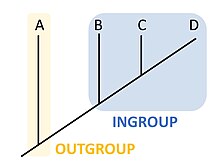
Back Autgrupa (kladistika) BS Grupo externo (cladística) Spanish برونگروه (کلادیستیک) Persian Groupes interne et externe (cladistique) French Külcsoport (kladisztika) Hungarian Outgroup Italian 外群 Japanese Grupa zewnętrzna Polish Grupo externo (cladística) Portuguese Utgrupp (kladistik) Swedish

In cladistics or phylogenetics, an outgroup[1] is a more distantly related group of organisms that serves as a reference group when determining the evolutionary relationships of the ingroup, the set of organisms under study, and is distinct from sociological outgroups. The outgroup is used as a point of comparison for the ingroup and specifically allows for the phylogeny to be rooted. Because the polarity (direction) of character change can be determined only on a rooted phylogeny, the choice of outgroup is essential for understanding the evolution of traits along a phylogeny.[2]
- ^ Grimaldi, David; Engel, Michael S.; Engel, Michael S. (2005-05-16). Evolution of the Insects. Cambridge University Press. ISBN 9780521821490.
- ^ Farris, J. S. (1982). "Outgroups and Parsimony". Systematic Biology. 31 (3): 328–334. doi:10.1093/sysbio/31.3.328. ISSN 1063-5157.